 Like any gigantic display, the Biennial is difficult to judge overall. The general level of work was probably a bit weaker than in 1994, especially in the Cuban work which has traditionally dominated the show. In this category, the first work in this year´s display was by Kcho, arguably the star of the moment in Havana (having won various international prizes and selling out his first show at Barbara Gladstone Gallery in New York). A variation on the artist´s familiar theme of boat pieces referring to the exodus from Cuba in recent years, the work repeated the symbolic, material and spatial language of much of his previous work; perhaps the newest element was the line of people eager to have their pictures snapped with the artist in front of the work´s bulk. If the politics of Kcho´s work felt watered down, the installation by Lázaro Saavedra did not; a field of blank tombstones arrayed in front of a stone wall deeply scarred by countless bullets, the work recalled not only the long struggle for Cuban independence but also the years just after 1959 when the La Cabaña fortress (site of the Biennial) was run by the newly victorious Che Guevara, whose »revolutionary tribunals« concluded with executions at exactly Saavedra´s site. Also among the Cuban participants were René Francisco Rodríguez and Carlos Estévez, both of whom presented dense, room-sized installations; in the case of the former the work, Taller de Reparaciones was an acerbic reflection on the material realities of life in Cuba with even fewer spare parts than ever, while Estévez´s Donde sueña el Demiurgo, also concerned with the texture of everyday life in Havana, amassed dozens of puppets, drawings and quotations of ´80s Cuban art. Like any gigantic display, the Biennial is difficult to judge overall. The general level of work was probably a bit weaker than in 1994, especially in the Cuban work which has traditionally dominated the show. In this category, the first work in this year´s display was by Kcho, arguably the star of the moment in Havana (having won various international prizes and selling out his first show at Barbara Gladstone Gallery in New York). A variation on the artist´s familiar theme of boat pieces referring to the exodus from Cuba in recent years, the work repeated the symbolic, material and spatial language of much of his previous work; perhaps the newest element was the line of people eager to have their pictures snapped with the artist in front of the work´s bulk. If the politics of Kcho´s work felt watered down, the installation by Lázaro Saavedra did not; a field of blank tombstones arrayed in front of a stone wall deeply scarred by countless bullets, the work recalled not only the long struggle for Cuban independence but also the years just after 1959 when the La Cabaña fortress (site of the Biennial) was run by the newly victorious Che Guevara, whose »revolutionary tribunals« concluded with executions at exactly Saavedra´s site. Also among the Cuban participants were René Francisco Rodríguez and Carlos Estévez, both of whom presented dense, room-sized installations; in the case of the former the work, Taller de Reparaciones was an acerbic reflection on the material realities of life in Cuba with even fewer spare parts than ever, while Estévez´s Donde sueña el Demiurgo, also concerned with the texture of everyday life in Havana, amassed dozens of puppets, drawings and quotations of ´80s Cuban art.
|
 |
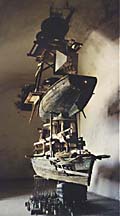
Kcho |

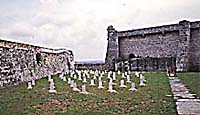
Lázaro Saavedra
|
|
| |
 There were other exceptional works. Reamillo and Juliet´s (Phillippines, 1964 and Great Britain, 1966) spectacular installation Jesus and the Jeeps: God Bless Our Voyage filled one room of the Casa de Asia to great effect with an old jeep, super-elaborately encrusted with plastic and electronic baubles while a video game played incessantly in the cab. The artists´ statement in the catalog is a strongly-worded denunciation of the globalization of western capitalism and the cancerous effects of consumer culture which »achieve a superlative malignity in the periphery of the Third World«. Luckily the rhetorics of the work were countered by a more flexible aesthetic which incorporated strong elements of irony into its vocabulary; in contrast to the busy-ness and overkill of the jeep´s treatment, a column of pistol-shaped paper cut-outs floated on a string, casting incongruously beautiful bird shadows. There were other exceptional works. Reamillo and Juliet´s (Phillippines, 1964 and Great Britain, 1966) spectacular installation Jesus and the Jeeps: God Bless Our Voyage filled one room of the Casa de Asia to great effect with an old jeep, super-elaborately encrusted with plastic and electronic baubles while a video game played incessantly in the cab. The artists´ statement in the catalog is a strongly-worded denunciation of the globalization of western capitalism and the cancerous effects of consumer culture which »achieve a superlative malignity in the periphery of the Third World«. Luckily the rhetorics of the work were countered by a more flexible aesthetic which incorporated strong elements of irony into its vocabulary; in contrast to the busy-ness and overkill of the jeep´s treatment, a column of pistol-shaped paper cut-outs floated on a string, casting incongruously beautiful bird shadows.
 In the next room, Erasure and Remembrance by Alfredo Juan Aquilizan (Phillippines, 1962) was a somber counterpart to the Jeep´s exuberance. In an almost totally darkened space, thousands of used toothbrushes had been carefully laid out in a soft, dilapidated carpet. While impressive in visual terms, the work´s real interest lay in the process the artist had undertaken; over a period of months, Aquilizan had personally collected the toothbrushes from a small town in the Phillippines. For him, the main point of the piece was the process of that collecting, which required him to get to know the people over a period of time. His original idea was to also collect a parallel group of toothbrushes in Havana, and mix them all together - he is tired of the parochialisms of »identity« in culture. This proved impossible however, either because in Cuba there was not a ready supply of discarded toothbrushes or because he did not have the time to find a way to accumulate them. In the next room, Erasure and Remembrance by Alfredo Juan Aquilizan (Phillippines, 1962) was a somber counterpart to the Jeep´s exuberance. In an almost totally darkened space, thousands of used toothbrushes had been carefully laid out in a soft, dilapidated carpet. While impressive in visual terms, the work´s real interest lay in the process the artist had undertaken; over a period of months, Aquilizan had personally collected the toothbrushes from a small town in the Phillippines. For him, the main point of the piece was the process of that collecting, which required him to get to know the people over a period of time. His original idea was to also collect a parallel group of toothbrushes in Havana, and mix them all together - he is tired of the parochialisms of »identity« in culture. This proved impossible however, either because in Cuba there was not a ready supply of discarded toothbrushes or because he did not have the time to find a way to accumulate them.
|
 |

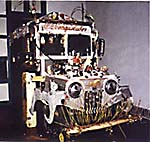
Reamillo and Juliet |
|
| |
 Laura Anderson´s (Mexico, 1958) Epitome or easy way to learn the nahuatl language, on first glance was yet another artistic monument to corn, »essential ingredient of the Americas«; on closer inspection however, the grains of corn turned out to be human teeth - thousands of them - which instantly transformed the work into a requiem for the continent´s violent process over the centuries since the Conquest, and its uncounted victims. The cobs were laid out on bamboo stands which recalled the Aztec displays of war trophies in the public plazas. Laura Anderson´s (Mexico, 1958) Epitome or easy way to learn the nahuatl language, on first glance was yet another artistic monument to corn, »essential ingredient of the Americas«; on closer inspection however, the grains of corn turned out to be human teeth - thousands of them - which instantly transformed the work into a requiem for the continent´s violent process over the centuries since the Conquest, and its uncounted victims. The cobs were laid out on bamboo stands which recalled the Aztec displays of war trophies in the public plazas.
 In fact for many of the Latin American artists, the Biennial´s theme of memory prompted references to lost lives, mutilated bodies, and other human remnants of violence. In exquisitely embroidered panels, Pablo van Wong´s (Colombia, 1957) series Obreption with ornament reproduced journalistic images of corpses, funerals and so on; the lushness of his colors and surfaces made the sinister images beautiful, deepening the sense of violence. Above the frames there were shallow boxes holding rows of thread spools, arranged in the form of military decorations. In fact for many of the Latin American artists, the Biennial´s theme of memory prompted references to lost lives, mutilated bodies, and other human remnants of violence. In exquisitely embroidered panels, Pablo van Wong´s (Colombia, 1957) series Obreption with ornament reproduced journalistic images of corpses, funerals and so on; the lushness of his colors and surfaces made the sinister images beautiful, deepening the sense of violence. Above the frames there were shallow boxes holding rows of thread spools, arranged in the form of military decorations.
|
 |
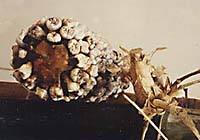
Laura Anderson |
|
| |
 Mortality and disease have been ubiquitous themes in contemporary art for more than a decade, both in the postindustrial centers and in the »small circuits« of the periphery which are no less affected by the epidemics and crises of identity which plague our era. In Suzann Victor´s (Singapore) dramatic work, Untitled, an old metal bed frame hovered high above the floor, draped with a huge blanket knitted together from thousands of small glass squares dotted with drops of blood. Roberto Huarcaya´s (Peru, 1959) the Return of the forgotten cloaked the armature of a spiral staircase in huge, startling photographs of faces, from infant to old man, alive and dead. Mortality and disease have been ubiquitous themes in contemporary art for more than a decade, both in the postindustrial centers and in the »small circuits« of the periphery which are no less affected by the epidemics and crises of identity which plague our era. In Suzann Victor´s (Singapore) dramatic work, Untitled, an old metal bed frame hovered high above the floor, draped with a huge blanket knitted together from thousands of small glass squares dotted with drops of blood. Roberto Huarcaya´s (Peru, 1959) the Return of the forgotten cloaked the armature of a spiral staircase in huge, startling photographs of faces, from infant to old man, alive and dead.
|
 |
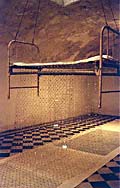
Suzann Victor |
|
| |
 Even if the ideas of »Third World« and »periphery« that were operative at the Biennial´s inception are now greatly changed, there was still no mistaking much of the work presented in Havana for the wealthy productions of the market centers. As in the past, there was a material reliance on the used, discarded and the recycled, with many of the resulting works bearing a patina which announced their approximate origin. Among these was the extensive installation by Romuald Hazoumé (Benin, 1962), made entirely of plastic objects washed ashore. In his hands, old detergent jugs became postmodern African masks, and a long stone wall covered with rows of old plastic beach thongs became a fascinatingly generic portrait gallery. Not far away another materially austere installation, by the very young South African Moshekwa Langa (b.1975), consisted of puddles of milk and scattered rocks on the old stone floor (by the second day, the room had filled with a sweet, rotting smell) illuminated at odd intervals by a pair of strobe lights. The milk, pooling in the floor´s uneven surface, became a de facto contour map of its topography, similar to Langwa´s other work which consisted of a tangle of nearly invisible threads laid on the floor and tracing a vague map occasionally demarcated with a place name spelled out in chalk. Langwa´s own explanation of the work, which referred to resolving dilemmas of identity, did not shed much light on the work´s mysterious allusions (the title of the first piece was The Permanent, Unfixed Image), but still the work had a potent, unforced aura. Eduardo Tokeshi´s (Perú) The Rescue Room, while also made of reclaimed materials (including beach thongs), achieved a magnificence through its meticulous fabrication and elegance. Even if the ideas of »Third World« and »periphery« that were operative at the Biennial´s inception are now greatly changed, there was still no mistaking much of the work presented in Havana for the wealthy productions of the market centers. As in the past, there was a material reliance on the used, discarded and the recycled, with many of the resulting works bearing a patina which announced their approximate origin. Among these was the extensive installation by Romuald Hazoumé (Benin, 1962), made entirely of plastic objects washed ashore. In his hands, old detergent jugs became postmodern African masks, and a long stone wall covered with rows of old plastic beach thongs became a fascinatingly generic portrait gallery. Not far away another materially austere installation, by the very young South African Moshekwa Langa (b.1975), consisted of puddles of milk and scattered rocks on the old stone floor (by the second day, the room had filled with a sweet, rotting smell) illuminated at odd intervals by a pair of strobe lights. The milk, pooling in the floor´s uneven surface, became a de facto contour map of its topography, similar to Langwa´s other work which consisted of a tangle of nearly invisible threads laid on the floor and tracing a vague map occasionally demarcated with a place name spelled out in chalk. Langwa´s own explanation of the work, which referred to resolving dilemmas of identity, did not shed much light on the work´s mysterious allusions (the title of the first piece was The Permanent, Unfixed Image), but still the work had a potent, unforced aura. Eduardo Tokeshi´s (Perú) The Rescue Room, while also made of reclaimed materials (including beach thongs), achieved a magnificence through its meticulous fabrication and elegance.
|
 |

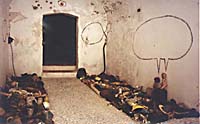
Romuald Hazoumé |
|

Eduardo Tokeshi |
 |
| |
 Carlos Garaicoa (Cuba, 1967) presented two »gardens«, one Japanese and the other Cuban; the former consisted of a traditional expanse of raked gravel interspersed with chunks of architectural ornaments that had fallen off of Havana´s decaying buildings, continuing the artist´s ironic treatment of the romanticizing of his deteriorating country. The »Cuban« garden took the form of a happening in an empty, garbage-strewn lot to which Garaicoa had invited an audience. While sipping drinks and chatting, we all noticed that small details of the landscape - the rusting shell of a car, for instance, had been commemorated in photographs inserted into the surrounding concrete walls as »virtual« replicas of the destroyed place itself. It was an acerbic commentary, especially in view of the now extensive renovations being undertaken in Havana´s historic district by international investors eager to open boutiques and cafes to capture the expanding tourist throngs (Garaicoa´s garden was not too far from the new Benetton shop). Carlos Garaicoa (Cuba, 1967) presented two »gardens«, one Japanese and the other Cuban; the former consisted of a traditional expanse of raked gravel interspersed with chunks of architectural ornaments that had fallen off of Havana´s decaying buildings, continuing the artist´s ironic treatment of the romanticizing of his deteriorating country. The »Cuban« garden took the form of a happening in an empty, garbage-strewn lot to which Garaicoa had invited an audience. While sipping drinks and chatting, we all noticed that small details of the landscape - the rusting shell of a car, for instance, had been commemorated in photographs inserted into the surrounding concrete walls as »virtual« replicas of the destroyed place itself. It was an acerbic commentary, especially in view of the now extensive renovations being undertaken in Havana´s historic district by international investors eager to open boutiques and cafes to capture the expanding tourist throngs (Garaicoa´s garden was not too far from the new Benetton shop).
|
 |

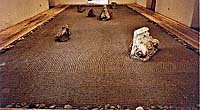
Carlos Garaicoa |
|
| |
 Not all the work in Havana employed such materially poor aesthetics, however, and photography in particular was a recurrent medium in the exhibition. Photo-Respirations, a lustrous series of works by Tokihiro Sato (Japan, 1957), featured portraits of isolated spots in Havana, blown up into huge translucent panels. Using time exposures, Sato caught glints of light scattered across the frame with a small flashlight and mirror; while the images are all empty of people, the little flashes of light seemed to become a ghost population. Using the same technique which, in Tokyo, connotes the cyclonic pace of development in that city, Sato´s images of Havana seemed to trace an opposite course of change. Marta María Pérez (Cuba) opened a stunning exhibition (in conjunction with the Biennial) of new work which continued her exploration of folk beliefs, using the format of photographic self-portraits. Other strong photographic work (covering a very broad spectrum of uses of the medium) by Alvaro Zinno (Uruguay, 1958), Tatiana Parcero (México, 1967), Victor Robledo (Colombia, 1949), Juan Enrique Bedoya (Perú, 1966) and Martín Weber (Argentina) was also presented. Not all the work in Havana employed such materially poor aesthetics, however, and photography in particular was a recurrent medium in the exhibition. Photo-Respirations, a lustrous series of works by Tokihiro Sato (Japan, 1957), featured portraits of isolated spots in Havana, blown up into huge translucent panels. Using time exposures, Sato caught glints of light scattered across the frame with a small flashlight and mirror; while the images are all empty of people, the little flashes of light seemed to become a ghost population. Using the same technique which, in Tokyo, connotes the cyclonic pace of development in that city, Sato´s images of Havana seemed to trace an opposite course of change. Marta María Pérez (Cuba) opened a stunning exhibition (in conjunction with the Biennial) of new work which continued her exploration of folk beliefs, using the format of photographic self-portraits. Other strong photographic work (covering a very broad spectrum of uses of the medium) by Alvaro Zinno (Uruguay, 1958), Tatiana Parcero (México, 1967), Victor Robledo (Colombia, 1949), Juan Enrique Bedoya (Perú, 1966) and Martín Weber (Argentina) was also presented.
continue 

|
 |

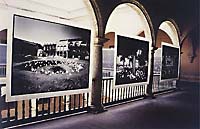
Tokihiro Sato |

|